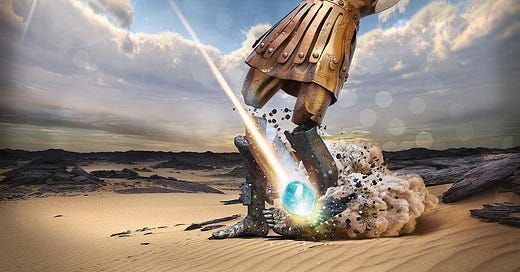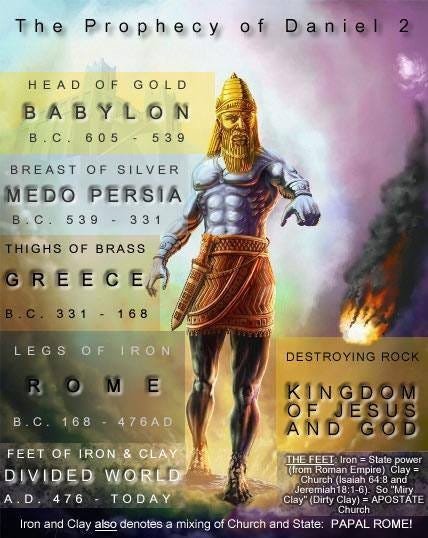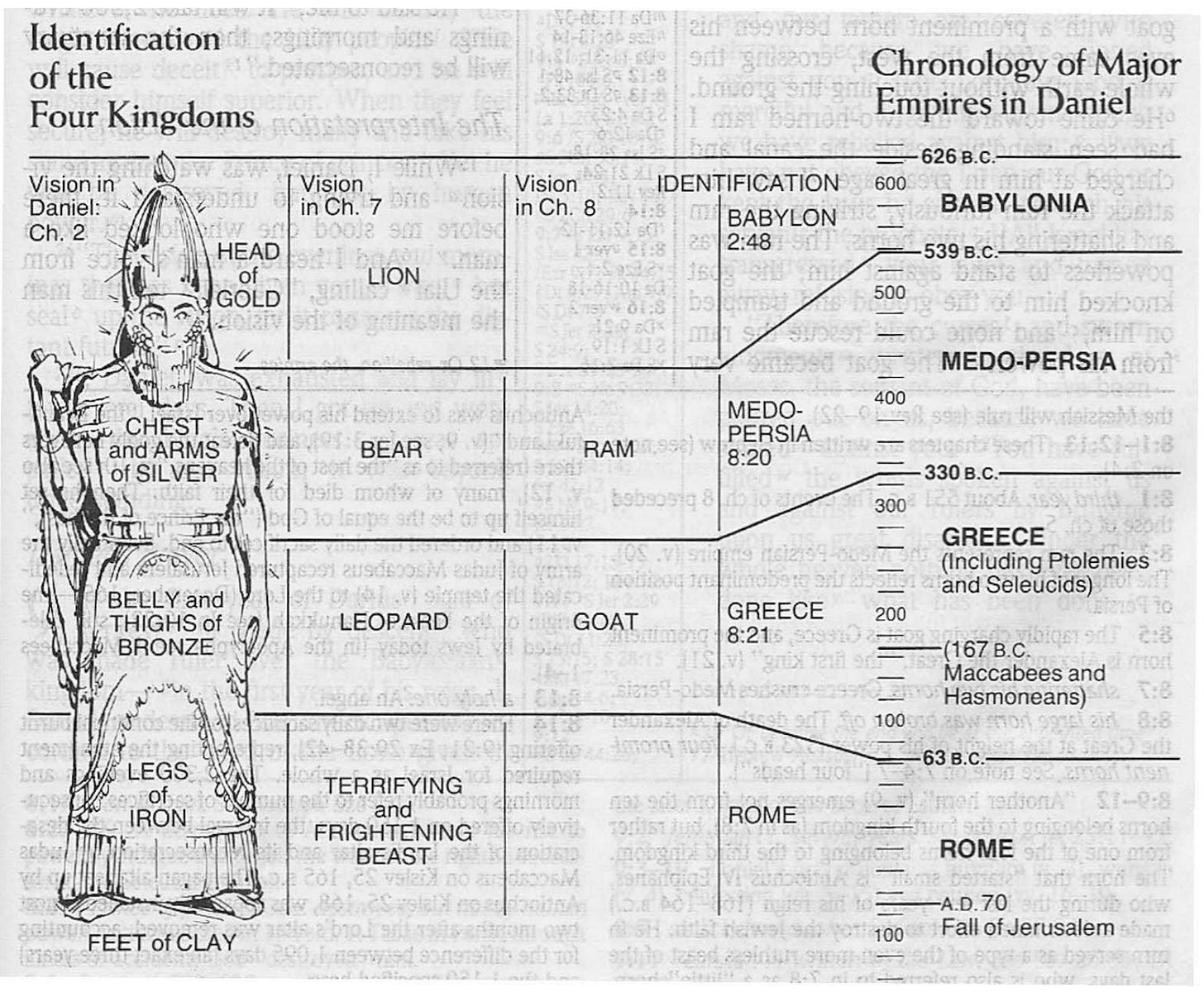Religious 9: Nebuchadnezzar’s dream
Eph 5:11:"…have no fellowship with the unfruitful works of darkness, but rather reprove them.”.
Amos 3:7 “…God will do nothing, but he revealeth his secret unto his servants the prophets.”
Why this post?
To identify the final beast that Daniel referred to.
Introduction
In my previous post I’ve illuminated the chasm that exists between Roman Catholicism and the Bible, and for a very specific reason. Most people are aware of Revelation and how it refers to the beast and its mark, and it’s as if this narrative is garnering attention the last while, but very few know who or what the beast is.
Similar to my previous posts, let’s turn to the Bible.
In this post I’ll start with Daniel and in the next, we’ll go down the dark abyss that’s Revelation. These two are related where Revelation continues and clarifies where Daniel left off.
Why prophecy matters
Just a quick reminder why we should study prophecy as noted by Amos and Isaiah:
Amos 3:7 - “Surely the Lord God will do nothing, but he revealeth his secret unto his servants the prophets.”
Isaiah 46:10 - “Declaring the end from the beginning, and from ancient times the things that are not yet done…“
He will NOT do anything without revealing it to his prophets!!!
Symbols
Understanding prophecy is not an art. It’s written in symbolic fashion BUT those symbols have all been defined by the Bible itself just as Peter noted:
2 Peter 1:20 “Knowing this first, that no prophecy of the scripture is of any private interpretation.”
Several have gone before us and have studied those symbols. Here’s a short version, here’s a long one for Revelation or in pdf form.
1 day = 1 year
I’ll elaborate one in detail and simply list those needed below. In several places the Bible refers to a day but we need to understand what it means prophetically:
Genesis 29:27, “Fulfil her week, and we will give thee this also for the service which thou shalt serve with me yet seven other years.”
Numbers 14:34, “After the number of the days in which ye searched the land, even forty days, each day for a year, shall ye bear your iniquities, even forty years, and ye shall know my breach of promise.”
Ezekiel 4:6, “And when thou hast accomplished them, lie again on thy right side, and thou shalt bear the iniquity of the house of Judah forty days: I have appointed thee each day for a year.”
Clearly a day in prophetic time is a literal year.
Obviously this dates back to Biblical times, but even Isaac Newton was a supporter:
William Miller also supported this and predates the Adventists movements:
In fact the list of supporters are long, as per wikipedia:
A few more symbols
Herewith a few key ones:
horn = salvation, kingly power, God’s power, exaltation, location of sacrificial blood, political strength (Dan 7:24, Dan 8:20-21);
sea = people (Rev 17:15);
beast = nation / kingdom / king, foolish, false teachers (Dan 7:23);
time = year (Dan 4:160;
woman = church (Jer 6:2, Jer 3:20, 2 Cor 11:2, Eph 5:22-25, Rev 21:9);
wind = true doctrine, false doctrine, commotion / war / strife / scattering / confusion (Eph 4:14, John 3:8, Is 64:6, Eph 2:2, Jer 25:31-33, Jer 49:36-37);
rock = Jesus (1Cor10:4, 3:10-14, Gen 49:24, Deut 32:4, 2Sam22:47, Is 28:16, 26:4).
Daniel
Daniel was so special that Jesus referred to him as a prophet. Perhaps Jesus meant for us to study his prophecies:
Matt 24:15 - “When ye therefore shall see the abomination of desolation, spoken of by Daniel the prophet, stand in the holy place, (whoso readeth, let him understand:)”
(I might in a future clarify this verse from what others taught me.)
Daniel’s prophesies reaches all the way back from 600BC to today. His revelation of Nebuchadnezzar’s dream is remarkable. To not only know what the king dreamt but also reveal its meaning.
But we know it’s really the Spirit that does the talking:
2 Peter 1:21 “21 For the prophecy came not in old time by the will of man: but holy men of God spake as they were moved by the Holy Ghost.“
Daniel had several prophecies and I’m lumping it into 3 three:
The statue (Nebuchadnezzar’s dream);
The king of the north and the king of the south; and
The 2300 day timeline.
In this post I’ll cover only the first. The others demand posts of their own.
Third time’s a charm
Daniel get the same message in three different visions. I know you forgot about the other two, right?
The Bible uses the number three 467 times. I’m not a scholar to academically claim why this is the case but there sure are a lot of coincidences. The God-head consists of three entities (seems to do with witness and function), and perhaps it’s to clarify or confirm statements. Some other occurrences of the three are:
Peter’s denial of Jesus;
Jesus appeared three times after the resurrection;
Jesus was tempted three times;
Three parables in Luke from sheep, to coins to sons;
Jonah’s three days in the fish;
Jesus was dead for three days; and
on and on and on.
Nebuchadnezzar’s dream and interpretation is so important that Daniel gets three variations of the vision. The first time is in Daniel 2 with the statue, then in another way in Daniel 7 with the four beasts, then again in Daniel 8 with the ram, the goat and the little horn.
All of these confirming the same thing in triplicate.
Nebuchadnezzar’s dream
This one is remarkable, it’s so well known that its gravity is diluted. Probably one of the most pervasive prophecies ever and there is very little confusion on what it meant. Daniel explained it, but in hindsight we know exactly which kingdoms those were.
Here’s a snapshot:
Herewith several images that aim to represent those kingdoms. Each of them have differing nuances and those matter. Unfortunately most attempt to insert ideas that are more than what was written:


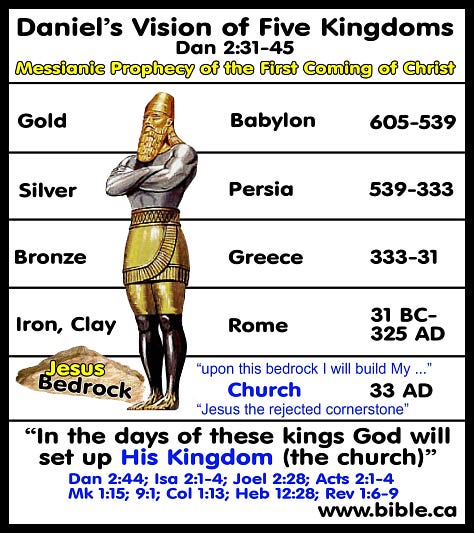

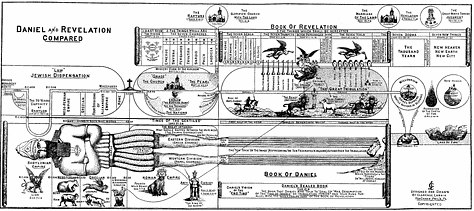
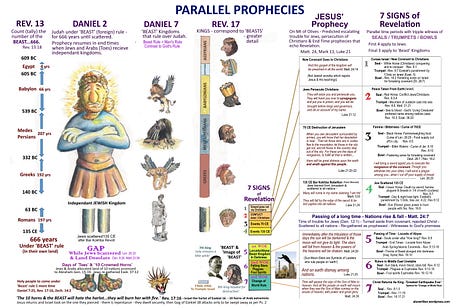

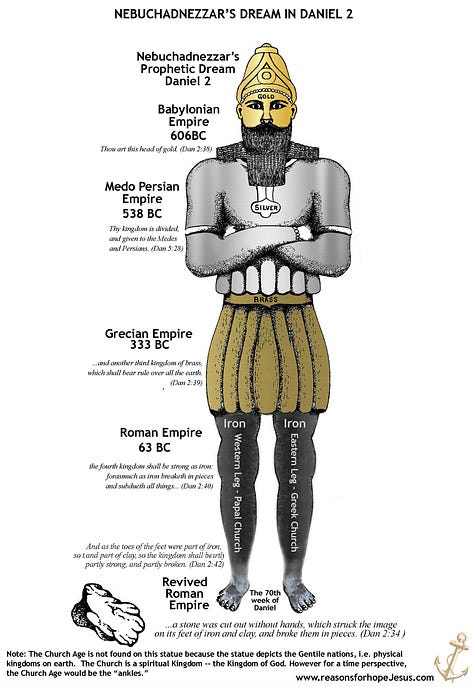

The kingdoms repeated three times in vision
Daniel received this vision three times, each time from a different angle and each time providing additional information. After considering several images, I felt this one is the most basic interpretation without inventing things:
The first kingdom
This one is easy because Daniel tells Nebuchadnezzar’s that the head of gold is him:
Daniel 2:38 - “And wheresoever the children of men dwell, the beasts of the field and the fowls of the heaven hath he given into thine hand, and hath made thee ruler over them all. Thou art this head of gold.“
We know that Babylon is often presented as a lion with wings:




The second kingdom
Medo-Persia was not equal in power as the Bear that is raised on one side represents. It has 3 ribs in its mouth which represents Lydia, Babylon and Egypt that it conquered. The Ram had two horns representing Media and Persia.
The third kingdom
The leopard represents the Greek empire that had four wings as it swiftly and aggressively expanded everywhere but finally split into the four kingdoms of Alexandre’s four generals (Cassander, Ptolemy, Antigonus, and Seleucus as per worldhistory.org).
The goat had one horn (Alexandre) which was broken off and became the four horns representing the four generals. And then from one of those came a little horn as per Dan 8:9 - “which waxed exceeding great, toward the south, and toward the east, and toward the pleasant land“.
The fourth kingdom
There is no disagreement that the fourth kingdom is that of the Roman Empire. We all know Iron was associated with the Roman Empire. What’s important to note is that the kingdom of iron did not go away, but mingled with clay and never had the same unity as before. From Daniel it seems that this one is different from those prior:
Daniel 2:40 - “And the fourth kingdom shall be strong as iron: forasmuch as iron breaketh in pieces and subdueth all things: and as iron that breaketh all these, shall it break in pieces and bruise.”
Daniel 7:7 - “After this I saw in the night visions, and behold a fourth beast, dreadful and terrible, and strong exceedingly; and it had great iron teeth: it devoured and brake in pieces, and stamped the residue with the feet of it: and it was diverse from all the beasts that were before it; and it had ten horns.”
Dan 8:9 - “…which waxed exceeding great, toward the south, and toward the east, and toward the pleasant land.“
Let’s consider the tail end of the fourth kingdom:
The statue ends up as ten toes of iron and clay that do not cleave;
The beast had ten horns BUT among it came a up little horn that plucked up three by the roots.
At the tail end of the Roman Empire, it was split into ten kingdoms:
The Alemanni, A.D. 351, Suabia, Alsace, and Lorraine. (See Gibbon, chapter 10, paragraph 26; 12:20; 19:20; 36:5; 49:22.)
The Franks, A.D. 351, Northwest Gaul. (Gibbon 19:20; 36:5).
The Burgundians, December 31, A.D. 406. (Gibbon 30:17.) Located in Burgundy A.D. 420. (Gibbon 31:39.)
The Vandals, December 31, A.D. 406. (Gibbon 30:17.) Located in Spain A.D. 409. (Gibbon 31:36.) Settled in Africa A.D. 429. (Gibbon 33:35.)
The Suevi, December 31, A.D. 406. (Gibbon 30:17.) In Spain A.D. 409. (Gibbon 31:36.)
The Visigoths, A.D. 408. (Gibbon 31:2, 14.) In Southwest Gaul A.D. 419. (Gibbon 31:39.) In Spain A.D. 467. (Gibbon 36:22; 38:2, 29.)
The Saxons entered Britain in A.D. 449. (Gibbon 31:41, 42; 38:33; Green’s England 1:17; Knight’s England 5:6.)
The Ostrogoths, in Pannonia A.D. 453. (Gibbon 35:16.) In Italy A.D. 489, final conquest A.D. 493. (Gibbon 39: 7, 8.)
The Lombards, A.D. 453, in Pannonia and Noricum, banks of Danube. (Weber’s Universal History, section 180; Gibbon 42:2; Encyclopaedia Britannica, article “Lombards.”) In Lombardy A.D. 567, 568. (Gibbon 45:5-7; Machiavelli’s History of Florence, chapters 1, 2.)
The Heruli, in Italy A.D. 475, 476. (Gibbon 36:28-33.)
The three plucked up were the:
Heruli in Italy in 493,
the Vandals in Africa in 533, and
the Ostrogoths in Italy in 538.
I cite this specifically because several other authors refer to ten kingdoms at the very end just before Jesus comes again but to me that is seeing more than what was written.
Who else knows this?
On the Nuremberg town hall, statues of these periods have been erected in 1524 by the protestant movement. This one shows the Greek on the left with the 4 headed leopard, and the Roman era with the beast with the ten horns on the right:
Geneva Bible from 1560 and 1599
A good friend of mine leant me his Geneva Bible of 1560 that has the comments from the original authors. Here is an introduction that is not afraid of the opinion of modern day scholars:
Those marginal notes had been, to a great extent placed in the Geneva Bible by the leaders of the Reformation including John Knox and John Calvin
Here is a snippet about the fourth beast from Daniel 2 verses 40-43:
Obviously spelling have changed and the use of the long f for an s has disappeared as explained by wikipedia.
Given all that, here are the original comments:
u = That is the Roman Empire that subdue all these other afore named.
w = After Alexandre were divided into Macedonia, Grecians, Syrias and Egyptians.
x = They shall have civil wars and continual discourse among themselves.
y = They shall by marriages and affinities think to make themselves stronger yet shall they never be joined in hearts.
We know all to well that the original Roman Empire split up into the countries of Europe but never again to be united. Even though several attempts was made by kings and rulers to intermarry Germans and English and more, it never succeeded. Even today the European Union struggles. The Euro is not accepted everywhere and their nations and tongues remain separated. (The marvel of the Tower of Babel.)
This is not only remarkable, but UNFATHOMABLE. How such a simple visual representation can be so accurate.
whydoneit?
Why did God send us his prophets?
I object: Asked and answered up top in Amos 3:7 and Is 46:10.

